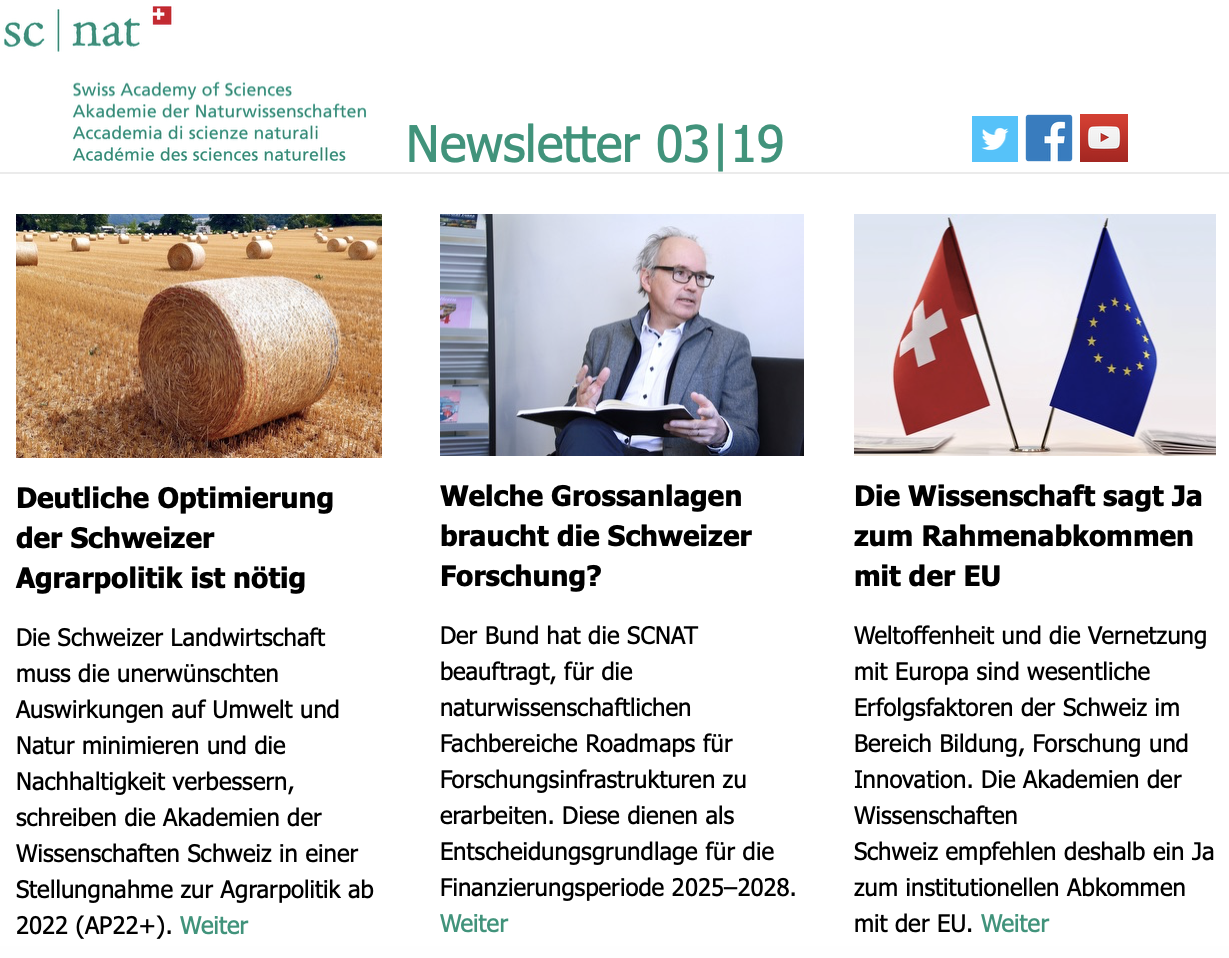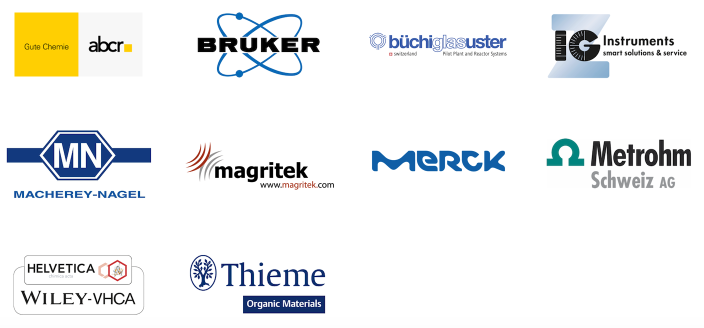SCNAT Newsletter, March 2019/2
Deutliche Optimierung der Schweizer Agrarpolitik ist nötig
Die Schweizer Landwirtschaft muss die unerwünschten Auswirkungen auf Umwelt und Natur minimieren und die Nachhaltigkeit verbessern, schreiben die Akademien der Wissenschaften Schweiz in einer Stellungnahme zur Agrarpolitik ab 2022 (AP22+). Weiter
Welche Grossanlagen braucht die Schweizer Forschung?
Der Bund hat die SCNAT beauftragt, für die naturwissenschaftlichen Fachbereiche Roadmaps für Forschungsinfrastrukturen zu erarbeiten. Diese dienen als Entscheidungsgrundlage für die Finanzierungsperiode 2025–2028. Weiter
Die Wissenschaft sagt Ja zum Rahmenabkommen mit der EU
Weltoffenheit und die Vernetzung mit Europa sind wesentliche Erfolgsfaktoren der Schweiz im Bereich Bildung, Forschung und Innovation. Die Akademien der Wissenschaften Schweiz empfehlen deshalb ein Ja zum institutionellen Abkommen mit der EU. Weiter
Der Permafrost in der Schweiz erwärmt sich wieder
Nach einer kurzen Pause von ein bis zwei Jahren setzte sich die Erwärmung des alpinen Permafrostes im hydrologischen Jahr 2017/18 wieder fort. Das zeigen die neusten Messungen des Schweizer Permafrostmessnetzes (Permos). Die Abkühlung ist in der Tiefe noch nicht sichtbar, aber in den oberflächennahen Schichten sind die Permafrosttemperaturen bereits wieder nahe bei oder über den bisherigen Rekordwerten und zeigen einen wieder aufgenommenen Erwärmungstrend. Weiter
Die Wissenschaft unterstützt den Klimastreik
Über 23’000 Wissenschaftlerinnen und Wissenschaftler aus Deutschland, Österreich und der Schweiz unterstützen die Anliegen der Demonstrantinnen und Demonstranten des Klimastreiks. Alleine in der Schweiz unterzeichneten 2600 Forschende eine entsprechende Stellungnahme von «Scientists for Future». Dieser zufolge reichen die derzeitigen Massnahmen zum Klima-, Arten-, Wald-, Meeres- und Bodenschutz bei weitem nicht aus. Weiter
Decarb science! But how?
Boston, Copenhagen, Kyoto: science is global and scientists are jetting around the world. Like the rest of society, science should lower its carbon emissions to net zero emissions in the next 30 to 50 years, in order to halt global warming below two degrees Celsius. Scientists and scientific institutions need to act now. Yet, how is it best to achieve decarbonisation? Is global science with only very few flights possible? Are there any tradeoffs for the scientific competitiveness? Join the symposium on 24 May 2019 held in Bern to explore this issue. More
Strassentransporte sollen weniger Klimagase verursachen
Die vorhandenen Instrumente der europäischen und schweizerischen Energiepolitik im Bereich der Mobilität reichen bei weitem nicht aus, um die Klimaziele des Übereinkommens von Paris zu erreichen. Dies besagt ein neuer Bericht des europäischen Akademien-Verbundes (EASAC). Der Bericht fokussiert auf den Strassentransport, der in Europa 72 Prozent des Treibhausgas-Ausstosses des Verkehrs ausmacht, und empfiehlt verschiedene Massnahmen. Weiter
Klima- und nachfragebedingte Wasser-Nutzungskonflikte im Alpenraum vermeiden
Die klimatischen Veränderungen und wirtschaftlichen Entwicklungen werden sich markant auf die Verfügbarkeit und den Bedarf an Wasser im Alpenraum auswirken. Dies kann, lokal wie auch grenzübergreifend, zu mehr Konkurrenz oder neuen Konflikten bei der Wasser- und Gewässernutzung führen. Ein Policy Brief des Alpen-Forums 2018 zeigt den politischen Handlungsbedarf und Steuerungsmöglichkeiten zur Vermeidung potenzieller Wasserkonflikte auf. Weiter
Mit Radio und Fernsehen auf Biodiversitätsmission
Das Schweizer Radio und Fernsehen (SRF) widmet der Biodiversität in der Schweiz einen langfristigen Schwerpunkt. Im Rahmen von «Mission B» Bestehende Sendungen und Plattformen beleuchten im Fernsehen, am Radio und online die Biodiversität aus wissenschaftlicher, wirtschaftlicher und gesellschaftlicher Sicht. Fachlich unterstützt wird SRF vom Forum Biodiversität der SCNAT. Weiter
On the top: Excellent research on 3450 meter a.s.l.
As part of the celebration activities of the Chemical Landmark 2019 that is awarded to the High Altitude Research Station Jungfraujoch, Switzerland's top site in environmental science, the Platform Chemistry of SCNAT organizes a symposium with national and international experts as lecturers and guests. The symposium held on 25 April 2019 in Bern and addresses the station’s international scientific role and also its remarkable historic background through the example of Max Perutz (Nobel prize in chemistry in 1962) and his early research work on the research station. More
Polar- und Höhenforschung: Ausschreibung für den Prix de Quervain 2019
Mit einem Beitrag von CHF 5000 belohnt der Preis junge Forscherinnen und Forscher für wissenschaftliche Projekte im Bereich der Polar- und Höhenforschung. Die Preisträger erhalten zudem die Gelegenheit, die Ergebnisse ihrer prämierten Arbeiten im Rahmen eines öffentlichen Symposiums mit namhaften Referenten einem interdisziplinären Publikum vorzustellen. Reichen Sie Ihre Bewerbung bis am 31. Mai 2019 ein. Weiter
Global Science Film Festival: Submit now!
The Global Science Film Festival aims to advance public understanding of science, environment and nature through the power of film. The festival takes place from November 15 to 17 2019 in Zurich and Bern. Panel discussions with film makers and scientists are organized by the SCNAT Platform Biology. Scientists and film makers are invited to submit their films to enter the program. More
Frühes Interesse an Naturwissenschaft und Technik wecken
Die neue Publikation von 21 anschaulich aufbereiteten Spielideen für Kinder im Alter von vier bis acht Jahren wird alle Erziehungspersonen inspirieren, und zwar im Kindergarten, in der Primarschule, bei der ausserfamiliären Betreuung und an ausserschulischen Lernorten. Damit schliesst das erste Projekt ab, welches die Akademien der Wissenschaften Schweiz mit dem Förderprogramm «Mint Schweiz» unterstützt haben. Weiter
Emotionen nüchtern betrachtet
Sie lösen Investitionen aus. Sie machen krank. Sie werden moralisch bewertet. Emotionen sind überall, die Forschung will sie dingfest machen. Gelingt das? Das erfahren Sie in der neusten Ausgabe des Forschungsmagazins «Horizonte». Weiter
Komplexes attraktiv vermitteln: CAS Wissenschaftsjournalismus
Wie lassen sich komplexe Zusammenhänge in Forschung und Wissenschaft attraktiv und verständlich vermitteln? Wie können Sie Inhalte aus Ihrem Fachgebiet einem breiten Publikum zugänglich machen? Im CAS Wissenschaftsjournalismus an der Schweizer Journalistenschule MAZ können Sie das lernen. Für Akademikerinnen und Akademiker, die publikumsnah kommunizieren möchten, oder den Einstieg in den Journalismus suchen. Start: 9. September 2019, Anmeldeschluss: 29. Juli 2019. Weiter
Akademie der Naturwissenschaften Schweiz (SCNAT)
Haus der Akademien | Laupenstrasse 7 | 3008 Bern
Andres Jordi | Tel. 031 306 93 23 | www.scnat.ch
Fragen und Anregungen:
Teilen auf Facebook, Twitter, http://newsletter.scnat.ch"
Chemistry Demonstration Day 2019 for High School Chemistry Teachers
EPFL and the Association of High School Chemistry Teachers from the Canton de Vaud are organizing a Demonstration Day in memory of the 150th anniversary of Mendeleev ’s table of the elements.
A group of chemistry teachers will show their best classroom demonstrations about the properties of the main chemical elements, using simple equipment like test tubes and beakers.
Chemistry Demonstration Day 2019
September 10, 2019, 09.00-15.00h
EPFL Lausanne, Lecture Hall CO3
Registration before August 30th, 2019. To register, please send a mail to
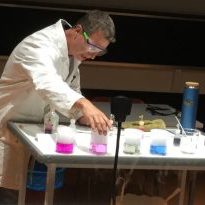

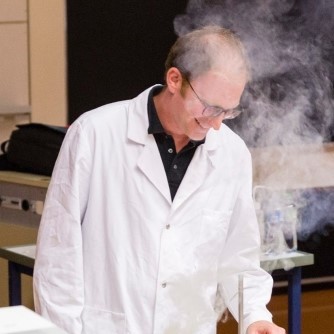
David Spichiger, SCS
27.03.2019
Masters Scholarships 2019 for International Students: Call for applications

The Alfred Werner Fund of the Swiss Chemical Society Foundation invites scholarship applications to carry out Master degree studies in Chemistry or Biochemistry at a Swiss University or a Federal Institute of Technology.
This call is for the 2019 - 2021 period and the Foundation offers a number of scholarships of CHF 25’000 as a onetime contribution to the cost of the 2-years Master study program. This opportunity targets foreign students in the top 10% of their undergraduate programs. Master degree courses in Switzerland are generally given in English.
Candidates must apply for admission to a M.Sc. program at a Swiss University or a Federal Institute of Technology (contacts on our website), and, at the same time request the institute to support them for an Alfred Werner Scholarship.
Each Swiss University and Federal Institute of Technology will submit to the Foundation ranked nominations by April 26, 2019. Since the admission and selection process may take as long as two months, candidates are encouraged to apply as soon as possible. Direct applications from candidates to the Foundation are not admitted.
The final selection committee includes representatives of the funding companies, Swiss Universities and Federal Institutes of Technology.
Results will be announced in May 2019.
Further information on http://scs-foundation.ch
The program is financially supported by
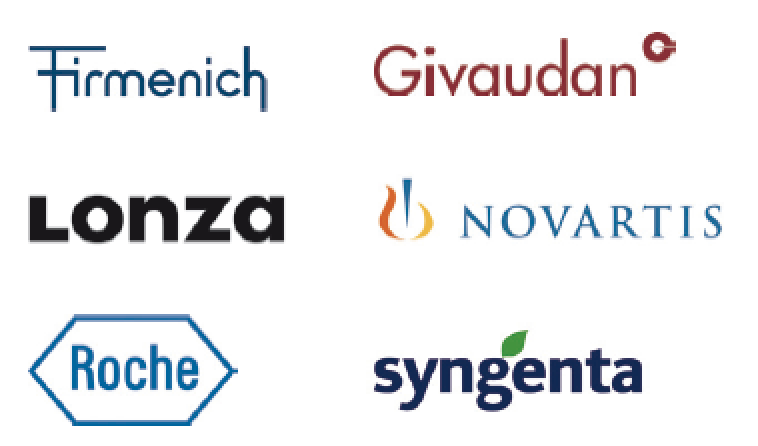
David Spichiger, SCS
27.03.2019
EuChemS Brussels News Updates, March 2019
Hello and welcome to the March edition of Brussels News Updates, the EuChemS newsletter keeping you up-to-date with the latest developments on the chemical sciences, as well as our news, activities and upcoming events!
On 8 March, we celebrated International Women’s day, which once more spotlighted the continuing gender inequality within society, but also within the scientific arena more specifically. Data indeed shows that whilst some progress has been made in reducing discrimination and encouraging equal opportunities for women, progress remains too slow and unequal across countries.
EuChemS broached the subject in a workshop organised on 7 March in the European Parliament on education, employability and EU research funding. The event was hosted by Member of the European Parliament van Nistelrooij, and featured a panel of speakers representing European institutions, academia and industry. You’ll find our full debrief below!
You can read the full newsletter online here.
European Highlights, Research, Innovation, Education, Entrepreneurship
Bridging education, employability and EU research funding
How are education, employability and research funding linked, and how can we ensure they are connected in a way that encourages equal opportunities for European chemical scientists? This was the topic for discussion at the EuChemS workshop ‘‘Chemical sciences for Horizon Europe, education and employability’’ in the European Parliament on 7 March, hosted by MEP Lambert van Nistelrooij. Read our top take-aways from the session!
Women in science
The new edition of the She Figures reportprepared by the European Commission puts into focus a clear message: women continue to be under-represented in science, technology, engineering and mathematics (STEM). Read our full debrief!
Horizon Europe: deal on time?
Members of the European Parliament have urged that a preliminary deal on Horizon Europe be made ahead of the May European elections, even if some matters, including the budget, would have to be settled after the new Parliament reports ScienceBusiness. Read the full story here.
Executive Board meeting in Lisbon
On 18 -19 February, the EuChemS Executive Board met in Lisbon, Portugal for the first Executive Board meeting of the year. Discussions focused on a wide range of issues, including upcoming activities and initiatives for the International Year of the Periodic Table (IYPT2019), as well as next year’s 50-year anniversary of EuChemS (initially known as FECS). Following discussions, the Executive Board was given the opportunity of visiting the congress centre which will host the 8th EuChemS Chemistry Congress in 2020!
‘’Is anyone reading our work?’’
The European Commission is currently preparing a project know as the “Knowledge4Policy” (K4P) platform, a set-up that aims to enable more fluid exchanges between scientists, policymakers and journalists. Beginning of March, the first focus group was held in which several scientists were asked to discuss their worries and their perception of how decision-makers access and use their research findings. Read the full debrief here.
Antimicrobial resistance: no signs of slowing down
A recent report released by the European Centre for Disease Prevention and Control (ECDC) and the European Food Safety Authority (EFSA) reveals that antimicrobials used to treat a variety of diseases continue to witness a drop in their effectiveness. Click for the full story.
Consultation and Roadmaps
Public consultation: Gender Equality in the EU
The European Commission has launched a public consultation to gather opinions on the current situation regarding gender equality in the EU and the priorities for the next 5 years.
Drop us a line if you would like to contribute to an EuChemS response!
Deadline to send us feedback: 20 May 2019
Public consultation: EFSA draft assessment of five phthalates used in plastic food contact materials
EFSA's Food Ingredients and Packaging (FIP) has launched an open consultation on five phthalates used in plastic food contact materials
Drop us a line if you would like to contribute to an EuChemS response!
Deadline to send us feedback: 1 April 2019
Funding, Nominations and Awards
European Chemistry Gold Medal
Every two years, the exceptional achievements of one scientist working in the field of chemistry in Europe are rewarded. The winner is awarded a gold medal and the opportunity to give the opening lecture at the next EuChemS Chemistry Congress (ECC). The call for nominations was opened on 1 March and will be open until 30 September 2019. Submissions can be made here.
Deadline: 30 September 2019
Website: https://www.euchems.eu/awards/european-chemistry-gold-medal/
EuChemS Events
EYCN Delegate Assembly, 21st JCF Frühjahrssymposium and 2nd European Young Chemists' Meeting
Bremen, Germany, 17 – 23 March
Website: http://bit.ly/2HwNXHV
1st GHI World Congress on Food Safety and Security (GHI2019)
Leiden, Netherlands, 24 – 28 March 2019
Website: http://bit.ly/2PrzhL8
6th European Chemical Biology Symposium / Meeting of EuChemS Division “Chemistry in Life Sciences”
Madrid, Spain, 3 – 5 April 2019
Website: http://bit.ly/2E7ojHD
37th Biennial Meeting of the Spanish Royal Society of Chemistry
San Sebastian, Spain, 26 – 30 May 2019
Website: http://bit.ly/2UUxfWe
14th International Symposium on Macrocyclic and Supramolecular Chemistry (ISMSC2019)
Lecce, Italy, 2 – 6 June 2019
Website: http://bit.ly/2yaNa9V
Organic Battery Days 2019 (OBD 2019)
Jena, Germany, 3 – 5 June 2019
Website: http://bit.ly/2F9UGGi
Other Events
Food Safety in the EU: Maintaining High Standards and Ensuring Transparency of Information
Brussels, Belgium, 11 April 2019
Website: http://bit.ly/2HmPcdC
European Chemistry Thematic Network (ECTN) General Assembly
Krakow, Poland, 12 – 14 April 2019
Website: http://bit.ly/2F5oGlm
11th Annual International Symposium on University Rankings and Quality Assurance 2019
Brussels, Belgium, 20 June 2019
Website: http://bit.ly/2TPd8vH
IUPAC 50th General Assembly, 47th IUPAC World Chemistry Congress, and Centenary
Paris, France, 5 – 12 July 2019
Website: http://bit.ly/2F8hhS3
EuChemS News
The 1st edition of Chemistry in Europe 2019 is available online.
The newsletter includes a number of interesting and highly relevant contributions, news, and upcoming events, such as an editorial by Pilar Goya, EuChemS President; an analysis on the survey on the employability of European chemists; input from the European Young Chemists’ Network and Members; well as news concerning the IYPT2019, and more!
EuChemS Year Book 2018 recently published
Read our recently published Year Book for an insightful overview of the many activities and initiatives EuChemS has been a part of over 2018. You can download it here.
SCS Spring Meeting 2019, Empa Dübendorf, April 5, 2019
The Swiss Chemical Society Spring Meeting is a one day symposium and provides a high quality program with national and international speakers of a certain topic.
It is also the platform for the Werner Prize Ceremony and the Werner Award Lecture.
SCS Spring Meeting 2019: «Novel Pathways in Materials Science»
Empa-Akadmie, Dübendorf
Fri, April 5, 2019, 09.00-17.30h
The organizers, Dr. Brigitte Buchmann and her team invites you to join the event and is looking forward to welcoming you in Dübendorf in early April 2019.
SCS Spring Meeting 2019, Flyer
Registration
Please register until before March 30, 2019 on the Symposium Website
Participation is free for SCS mebers and costs CHF 50.00 for non-members.
Program
| 09.00 | Welcome Coffee, Registration |
| 09.30 | Opening of the symposium, welcome message Dr. Brigitte Buchmann, Head of Department Mobility, Energy and Environment, Empa |
| 09.45 | Prof. Dr. Mercouri Kanatzidis, Department of Chemistry, Northwestern University, Evanston (USA) «Chemistry and Devices from Halide Perovskites Semiconductors» |
| 10.35 | Dr. Maryna Bodnarchuk, Swiss Federal Laboratories for Materials Science and Technology, Empa, Dübendorf (SUI) «Colloidal Quantum Dots: from their Discovery to Applications» |
| 11.25 | Prof. Dr. Edward Sargent, Electrical and Computer Engineering, University of Toronto (CAN) |
| 12.15 | Lunch |
| 13.00 | SCS General Assembly 2019 |
| 13.30 | Werner Prize Award Lecture 2019 Prof. Jeremy Luterbacher, EPFL Lausanne (SUI) «Protect and serve: acetal formation during biomass fractionation as a toolkit for reducing degradation and introducing new reactivity» |
| 14.20 | Prof. Dr. Christophe Copéret, Laboratory of Inorganic Chemistry, ETH Zurich (SUI) «Molecular Understanding and Controlled Functionalization of Surfaces Towards Single-Site Catalysts and Beyond» |
| 15.10 | Coffee Break |
| 15.40 | Prof. Dr. Jürgen Janek, Institute of Physical Chemistry & Center for Materials Research, Justus-Liebig University Gießen, (GER) and BELLA, Institute of Nanotechnology, Karlsruhe Institute of Technology (GER) «Advanced Solid Electrolytes and the Development of Solid State Batteries» |
| 16.30 | Prof. Dr. Michele Ceriotti, Labaratory of Computational Science and Modelling, EPFL Lausanne (SUI) «Physics-Based Machine Learning for Atomistic Modelling» |
| 17.20 | Closing remarks, Aperitif |
Sponsors
Exhibitors
David Spichiger, SCS
01.02.2019
Page 66 of 299

